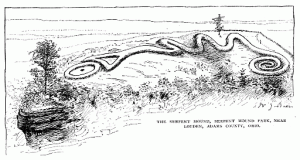Geography of Ohio and the United States
Prehistory of the Ohio Valley
Thomas Humphrey

Overview
Above is a sketch drawn in 1890 by William Jacob Baer. It depicts the Serpent Mound in Adams County, Ohio, which has been dated back to roughly 1000 AD, although some scientists date the site much earlier. Some researchers think the Mound represents a rattlesnake, which held mystical importance among many Mississippian groups of indigenous people. Some archeologists argue the Mound was built as a ceremonial site by the Fort Ancient people, while others insist the curves and head of the serpent align with the summer solstice and other astronomical times of the year. What is clear, however, the area around the Mound contains artifacts that connect the region to other Mississippian groups who built Cahokia, the largest and most complex site north of enormous cities in what is now Mexico.
Take a look at this short piece on it, explore the website listed, and be prepared to answer questions regarding the mound.
Readings
Please read through the following sites.
- https://web.archive.org/web/20040813224500/http://www.mnsu.edu/emuseum/archaeology/sites/northamerica/serpent.html
- http://www.ancientohiotrail.org/sites/serpent-mound
- Comic about the Serpent Mound by Sarah Hume https://web.archive.org/web/20201203230102/https://www.ohiohistory.org/learn/collections/archaeology/archaeology-blog/november-2020/newark-earthworks-journalistic-comichttps://www.ohiohistory.org/learn/collections/archaeology/archaeology-blog/November-2020/newark-earthworks-journalistic-comic
Lab Questions
- Whoever built the serpent mounds in southern Ohio chose the spot for a reason. Which characteristics are mentioned in the reading?
- How does a relic built by people who lived at least a thousand years ago still shape our community? How does it shape how we view ourselves and our history?

